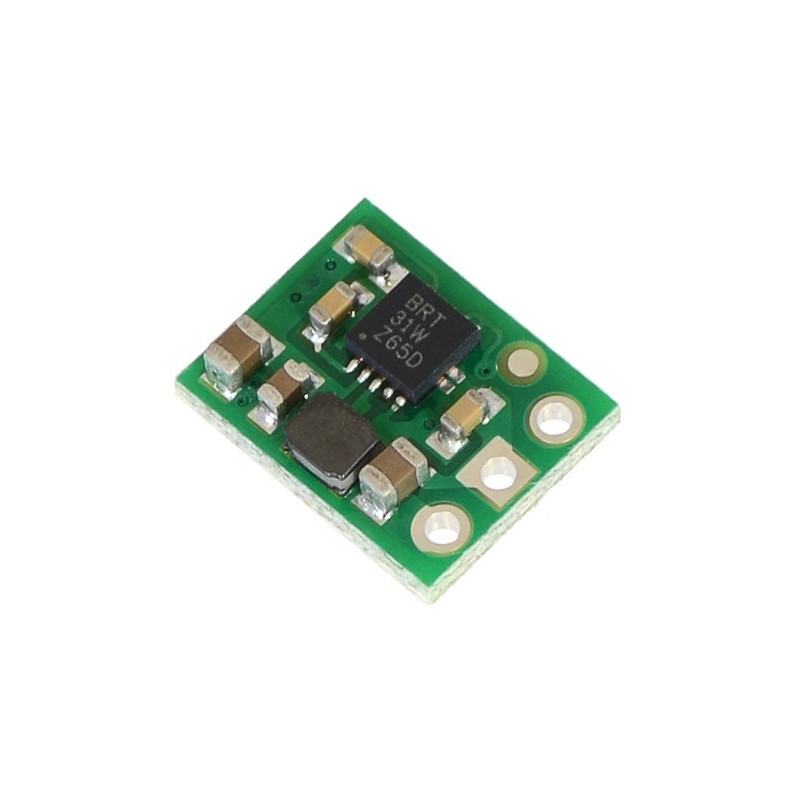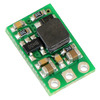

Pololu 5V Step-Up Voltage Regulator U1V10F5
This tiny (0.35"×0.45") U1V10F5 switching step-up (or boost) voltage regulator efficiently generates 5 V from input voltages as low as 0.5 V. Unlike most boost regulators, the U1V10F5 automatically switches to a linear down-regulation mode when the input voltage exceeds the output. The pins have a 0.1" spacing, making this board compatible with standard solderless breadboards and perfboards.
 |
This 5 V boost (step-up) voltage regulator generates higher output voltages from input voltages as low as 0.5 V, and it also automatically switches to a linear down-regulation mode when the input voltage exceeds the output. This makes it great for powering 5 V electronics projects from 1 to 3 NiMH, NiCd, or alkaline cells or from a single lithium-ion cell.
When boosting, this module acts as a switching regulator (also called switched-mode power supplies (SMPS) or DC-to-DC converters) and has a typical efficiency between 70% to 90%. The available output current is a function of the input voltage, output voltage, and efficiency (see Typical Efficiency and Output Current section below), but the input current can typically be as high as 1.2 A. This regulator is also available with a fixed 3.3 V output, and very similar 3.3V, 5V, and adjustable-output versions are available with a true shutdown option that turns off power to the load.
The regulator’s thermal shutdown engages at around 140°C and helps prevent damage from overheating, but it does not have short-circuit or reverse-voltage protection.
 |
The boost regulator has three connections: input voltage (VIN), ground (GND), and output voltage (VOUT).
The input voltage, VIN, must be at least 0.5 V for the regulator to turn on. However, once the regulator is on, the input voltage can drop as low as 0.3 V and the 5 V output voltage will be maintained on VOUT. Unlike standard boost regulators, this regulator has an additional linear down-regulation mode that allows it to convert input voltages as high as 5.5 V down to 5 V for small to moderate sized loads. When the input voltage exceeds 5 V, the regulator automatically switches to this down-regulation mode. The input voltage should not exceed 5.5 V. Please be wary of destructive LC spikes that might cause the input voltage to surpass 5.5 V (see below for more information).
The three connections are labeled on the back side of the PCB, and they are arranged with a 0.1" spacing along the edge of the board for compatibility with solderless breadboards, connectors, and other prototyping arrangements that use a 0.1" grid. You can solder wires directly to the board or solder in either the 3×1 straight male header strip or the 3×1 right-angle male header strip that is included.
 |
The efficiency of a voltage regulator, defined as (Power out)/(Power in), is an important measure of its performance, especially when battery life or heat are concerns. As shown in the graphs below, this switching regulator typically has an efficiency of 70 to 90%.
 |
The maximum achievable output current is approximately proportional to the ratio of the input voltage to the output voltage. If the input current exceeds the switch current limit (typically somewhere between 1.2 and 1.5 A), the output voltage will begin to drop. Additionally, the maximum output current can depend on other factors, including the ambient temperature, air flow, and heat sinking.
When connecting voltage to electronic circuits, the initial rush of current can cause damaging voltage spikes that are much higher than the input voltage. In our tests with typical power leads (~30" test clips), input voltages above 4.5 V caused voltage spikes that could potentially damage the regulator. You can suppress such spikes by soldering a 33 µF or larger electrolytic capacitor close to the regulator between VIN and GND.
More information about LC spikes can be found in our application note, Understanding Destructive LC Voltage Spikes.
 |
Pololu 3.3V Step-Up Voltage Regulator U1V10F3 |
 |
Pololu 12V Step-Up Voltage Regulator U3V12F12 |
 |
400-Point Breadboard |
Data sheet
Manufacturer BTC Korporacja sp. z o. o. Lwowska 5 05-120 Legionowo Poland sprzedaz@kamami.pl 22 767 36 20
Responsible person BTC Korporacja sp. z o. o. Lwowska 5 05-120 Legionowo Poland sprzedaz@kamami.pl 22 767 36 20
DC-DC Step-up converter module based on the U3V70F5 system. Input voltage 2.9 ... 5V, output voltage 5V, maximum current 10A. Two mounting holes. Polol 2891
Step-up DC-DC converter module based on the LM2587 circuit, input voltage 3.5..30V, regulated output voltage 4..30V. The module is equipped with ARK connectors
No product available!
Step-Up DC-DC converter module. It has an input voltage of 1.3 to 16 V, an output voltage of 15 V and a maximum input of up to 2 A. Pololu 4946
Step-Up DC-DC converter module. It has an input voltage of 1.3 to 16 V, an output voltage of 9 V and a maximum input of up to 2 A. Pololu 4944
A handy way to power 12V powered devices with a center-positive 2.1mm DC barrel jack from a USB port. Adafruit 2778
No product available!
Pololu 9V Step-Up Voltage Regulator U3V50F9
DC-DC Step-up converter module based on the U3V70F5 system. Input voltage 2.9 ... 5V, output voltage 5V, maximum current 10A. Two mounting holes. Polol 2891
The Step-UpU1V11F5 Buck Voltage Regulator module with output voltage 5V, input voltage range of 0.5-5.5V and a maximum output current of 1.2A. Pololu 2562
No product available!
Step-Up converter with an output voltage of 2 to 28 V, an input voltage of 2 to 24 V and a maximum current of 2 A
No product available!
A small DC - DC boost module that converts a 0.9..5V power source to standard 5V, making it capable of supplying power to an Arduino microcontroller and other small electronic devices that use a 5v input. It integrates a PFM DC-DC boost control chip. FIT0471
Step-Up converter U3V70A with an output voltage from 4.5 to 20 V, an input voltage from 2.9 to VOUT and a maximum output current of 10 A. Pololu 2890
No product available!
Step-Up converter U3V70F15 with an output voltage of 15 V, an input voltage from 2.9 to 15 V and a maximum output current of 10 A. Pololu 2896
No product available!
DC-DC Step-up converter module based on the U3V70F9 system. Input voltage 2.9-9V, output voltage 9V, maximum current 10A. Two mounting holes. Polol 2894
Step-Up DC-DC converter module. It has an input voltage of 1.3 to 16 V, an output voltage of 6 V and a maximum input of up to 2 A. Pololu 4942
Step-Up converter with an output voltage of 5 to 28 V, an input voltage of 2 to 24 V and a maximum current of 2 A
The Step-Up Buck Voltage Regulator module with output voltage of 3.3V and input voltage range of 1-3V and a maximum output current of 200 mA. SparkFun PRT-10967
No product available!
DC-AC converter, also referred to as an inverter. It converts a constant voltage (DC) of 12 V to an alternating voltage (AC) of 110 V, 200 V, 220 V or 280 V

Pololu 5V Step-Up Voltage Regulator U1V10F5
